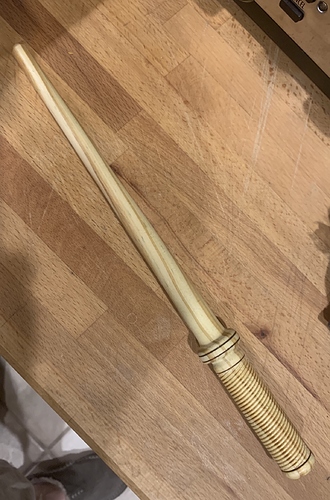I made a couple of “magic” wands and their boxes using my XXL. I hope a link to a project hosting site is ok. https://www.simplecove.com/1106/magic-wands-wand-boxes/
beautiful ! great work…
Love love love love them–the calligraphy, wax seals, wood work (of course)–very nice.
Your attention to detail is enviable, those look amazing!!!
Funny thing, my wife is a huge Harry Potter fan. She happens to be out tonight, and I happen to be needing a new lathe project 
Dan
Thank you!
If you can turn, you can probably bang these out a lot faster than I could right now. I hope she likes it!
Wow! Those are incredible! You did a really great job and I’m sure made them very happy.
Would you share some more details of how you made them? How did you do the 2-sided carving? What tools did you use? How long did it take?
I hope you don’t mind my just providing a link. I detailed the process when I did a similar but larger project and someone asked. All the details are the same for the wands, just smaller scale. Hope this helps!
Edit: Oh, but you asked about time too. Each side took about 1.5 hours with tool changes.
Had my 21 year old son make one(with a little help) first time on the lathe:
About 45 minutes start to finished. Sanded to 600 grit, applied walnut oil, then HUT wax and polish with a paper towel. Cheap piece of pine I had kicking around. Was fun to see my son take to it and was genuinely happy when he left with his new “tool of magic” to go home.
Dan
The threaded handle is cool as heck! Nice work to the both of you!
Perfect! Links are great. Thanks
Also, I haven’t used a tapered endmill yet. Do they provide extra rigidity for small tips?
I’d bet you could cut “threadlike” threads on your 2 sided cuts, but you’d need a very small bit or coarser threads. On the lathe I use a spiraling tool and it literally takes less than a minute to do them, but it takes some practice and soft open grain wood like this pine doesn’t always yield great results. Yours are definitely a step up from our creation, this was more about Dad and son time and learning a little bit of a new skill. Since he’s mostly grown up, and he didn’t do shop with me when he was little, we could have turned an ugly ashtray and I would have been just as happy. Thanks a bunch for the inspiration!!
Dan
Extra rigidity for small tips is one thing. I use them pretty much exclusively for the finishing pass on my terrain relief models due to their greatly increased reach.
I usually go with one (from Amazon) with a 1/4" shank and 0.5mm tip, and it gives me 31.75mm of thread length to work with. That lets me do a 31mm-deep 3D carve in one (post-roughing) pass, which quite helps the efficiency.
You said it exactly.
Just curious, how do you make your terrain models? I have an idea for a project that involves both a topographic model and a bathymetric (sea floor) model.
Awesome, thanks!
@JFischer911 - He has a whole post here in the forums about it. Check it out.
I do have a forum thread about it, but since that started, I’ve pretty much reworked the whole process (even writing a QGIS plugin, which you can now install from the plugins repository using the built-in plugin manager). I’m planning to make some more terrain relief models for a hiking/camping trip I’ve got coming up, so I’ll use that to document the current state of my art from the top and in full.
Awesome, I want to make a terrain model of a specific area and would love some guidance on that from how you do it. I was just going to follow your old post.
